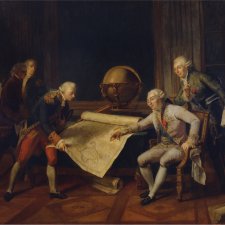Joseph-Antoine Raymond Bruny D'Entrecasteaux (1739-1793), French admiral and navigator, made detailed surveys and charts of the southern coast of Tasmania over two visits in 1792 and 1793. Having joined the navy aged fifteen, he rose to the role of governor of Île de France and Île Bourbon in the Indian Ocean. In 1791 he commanded the ships La Recherche and L'Espérance on an expedition to search for the navigator La Pérouse, who had gone missing after departing from Botany Bay in March 1788. D'Entrecasteaux's expedition failed to explain La Pérouse's disappearance, but the voyage produced important surveys of several Pacific islands, and reports of their vegetation, weather patterns, languages and cultures. In December 1792 D'Entrecasteaux hit the southwest coast of New Holland near Cape Leeuwin. From there, he sailed around the lower edge of the continent off Nuyts Land (now South Australia) until veering off to Van Diemen's Land on 4 January 1793. There, D'Entrecasteaux discovered a river that he called the Riviére du Nord, but when the Englishman John Hayes arrived a few months later he renamed it the Derwent River. After surveying the seas around the Solomon Islands, the expedition headed for the Dutch Islands, but D'Entrecasteaux died at sea from scurvy. Tasmania's D'Entrecasteaux Channel is named after the navigator, as is Bruny Island.
Collection: National Portrait Gallery
Purchased 2009



On one level The Companion talks about the most famous and frontline Australians, but on another it tells us about ourselves.



Joanna Gilmour describes some of the stories of the individuals and incidents that define French exploration of Australia and the Pacific.



Visit us, learn with us, support us or work with us! Here’s a range of information about planning your visit, our history and more!